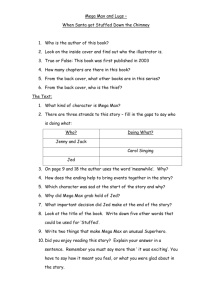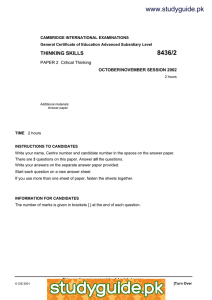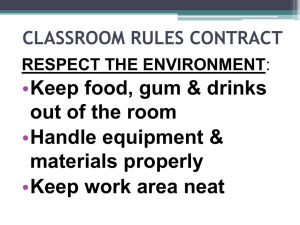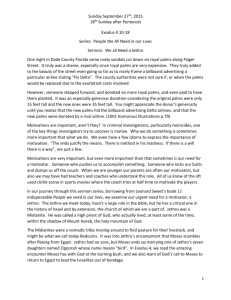The Do`s and Dont`s with Court Proceedings with Foodborne
advertisement
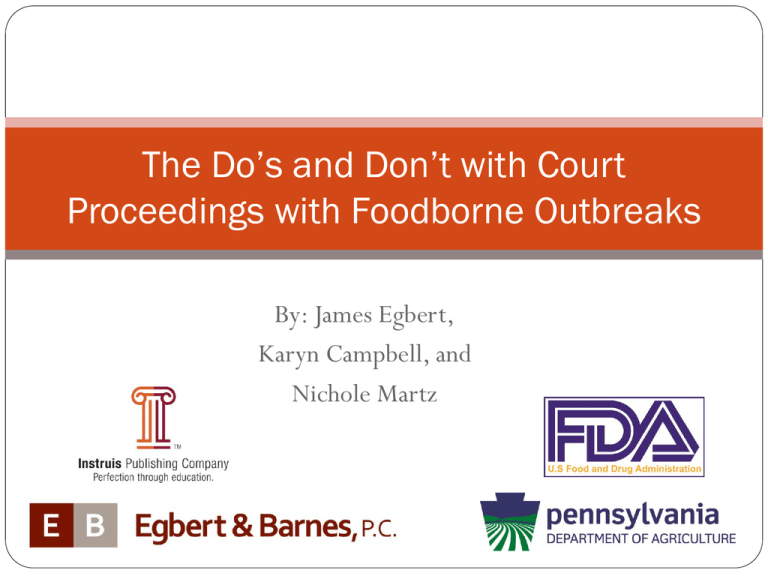
The Do’s and Don’t with Court Proceedings with Foodborne Outbreaks By: James Egbert, Karyn Campbell, and Nichole Martz Objectives Preparing for Court Do’s and Don’ts in Court Review the Fact Pattern Testimony (Role Play) Civil Matter State Matter Preparing for Court What do you have to prove to win? What is the law? What evidence do I need? Physical evidence Expert reports Witnesses Hearsay??? What is the law? The law changes from state to state. Federal law State law Administrative codes (county and local municipality) Is this the correct law for this case? Do you know the current law? The law will tell you what facts are needed to prove the case. (Evidence) What evidence do I need? Types of Evidence Direct evidence Evidence that directly proves a fact Standing outside while it is snowing Circumstantial evidence Proves a fact from which an inference of the existence of another fact may be drawn Waking up and seeing snow on the ground Forms of Evidence Types of Evidence Physical evidence Material object that plays some actual role in the matter that gave rise to the litigation Witness testimony Generally, may only testify as to facts personally observed by that witness Generally, can not give opinions Forms of Evidence Types of Evidence Expert testimony Have knowledge outside the scope of the average juror Can give opinions Hearsay An out of court statement offered for the truth of the matter asserted Forms of Evidence (for a Regulator) Samples Analytical Results Inspection Reports Records Collected During an Inspection Photographs Other Documents and Writings Affidavits Collection Reports Investigative Memoranda Regulatory Notes Do’s and Don’ts of Preparing for Court Do’s Be organized! Make sure you have all of your evidence Have enough copies for the court and other attorneys Make sure your witnesses are prepared Subpoena? Do they know where to go? Confirm their appearance Call the court the day before to confirm the hearing Do’s and Don’ts of Preparing for Court Don’ts Don’t wait until the last minute Don’t make anything up Circumstantial Evidence vs. Fabrication Do’s and Don’ts of the Court Room Do dress professionally First impressions count Nice church or office attire You are more likely to be treated with respect if you dress appropriately Don’t dress professionally if your profession is the local drunkard or a rock musician Torn t-shirts? Sweat pants? Bandanna? Really!? If you look like a gang member or criminally insane you will most likely be treated like one. Say Yes to the Dress! Do’s and Don’ts of the Court Room Do be on time Be early – It shows you care about your case and that you take the courts time seriously Don’t be late It shows you are unreliable You could lose by default Do’s and Don’ts of the Court Room Do be respectful Speak up, say “sir,” “ma’am,” and “your honor” Don’t talk back Wait your turn Don’t be disrespectful In court, being disrespectful, flippant, rude, or nonchalant just makes the judge like you less Another word for disrespect is contempt Do’s and Don’ts of the Court Room Do listen and follow instructions When in doubt, ask the clerk! Be courteous to the judge’s staff. If your rude, the clerk will be less likely to help you. Don’t make up your own rules Acting outside of the rules, just irritates the judge. Guess what happens when a judge thinks you have wasted his or her time? Do’s and Don’ts of the Court Room Do’s of Giving Testimony Tell the truth and be straightforward even if it means you will lose Keep your emotions under control Listen to the entire question before answering If you do not understand the questions, say so. Answer “yes” if asked if you and your lawyer went over your testimony to prepare for trial Be pleasant to opposing council, even if you hate his or her guts Have a positive attitude Try to act naturally Do’s and Don’ts of the Court Room Don’ts of Giving Testimony Don’t tell lies – even small ones Don’t chew gum Don’t make faces Don’t try to memorize your answers Don’t worry if your forgot something Don’t interrupt the person asking questions Don’t try to be cute or tell jokes Don’t act hostile Fact Pattern: Parties Facility: Convenience store/ Restaurant/Gas Station Name: Jed’s One Stop Owner: J. D. Clampett Manager: Jethro Bodine Health Inspector: Jane Hathaway Injured Parties: Lester Flats, Earl Scruggs, Milburn Drysdale Fact Pattern: Inspection Jed’s One Stop November 15, 2013 – Inspected by Hathaway December 15, 2013 – Re-inspected by Hathaway February 12, 2014 – Spot check inspection by Hathaway Fact Pattern: Product Chicken Secret Recipe Time-temperature abuse of food Improper holding of food Food was observed uncovered, risking contamination Hand washing sink in preparation area did not have hand soap Before Court Preparation What’s the law? Who has to testify? What evidence do I need? Witness Examination For the prosecution Jane Hathaway Jed Clampett Dr. Oz – medical expert For the defense Jed Clampett Jethro Bodine Granny Jane Hathaway What prep is involved? If you represented Jane, what questions would you ask her? If you represented Jed, how would your cross examine her? Dr. Oz How would your prepare Dr. Oz? Jed If you were the prosecutor what would you do to cross examine him? Jethro Bodine Is there any value in having Jethro testifying? Thank you for you time!

